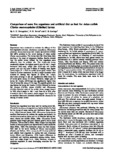Comparison of some live organisms and artificial diet as feed for Asian catfish Clarias macrocephalus (Günther) larvae

View/Open
Date
2005Page views
353Metadata
Show full item recordCited times in Scopus
- Citations
- CrossRef - Citation Indexes: 15
- Scopus - Citation Indexes: 30
- Captures
- Mendeley - Readers: 60
Share
Abstract
Experiments were conducted to evaluate the efficacy of five live organisms (Artemia, Brachionus calyciflorus, Chironomus plumosus, Moina macrocopa and Tubifex sp.) and an artificial diet (40% protein) in the larval rearing of Asian catfish Clarias macrocephalus. The larvae were fed three times daily starting at the onset of exogenous feeding. Results showed that the catfish larvae utilized the live organisms more efficiently than the artificial diet. The Tubifex-fed larvae consistently showed the highest growth rate. In trial 1, length increment (64.9 mm), weight gain (3192 mg) and specific growth rate (13.1%) after 8 weeks of feeding were significantly higher (P < 0.05) in catfish larvae given Tubifex than those in all other treatments. In trial 2, length increment after 4 weeks of feeding was highest in larvae fed Tubifex (22.9 mm) although it did not significantly differ from that of larvae given Moina (21.0 mm). However, weight gain of larvae fed Tubifex (253.0 mg) was significantly higher than that of larvae fed Moina (171.6 mg). The specific growth rate was highest for larvae fed Tubifex (15.0%) followed by larvae fed Artemia (14.5%), Moina (14.4%) and Chironomus (12.0%). Survival rates of the catfish larvae ranged from 9 to 39% after 8 weeks in trial 1 and from 26 to 83% after 4 weeks in trial 2. The present results suggest that Tubifex is an excellent food and a potential substitute for Artemia in the rearing of catfish larvae.
Suggested Citation
Evangelista, A. D., Fortes, N. R., & Santiago, C. B. (2005). Comparison of some live organisms and artificial diet as feed for Asian catfish Clarias macrocephalus (Günther) larvae. Journal of Applied Ichthyology , 21(5), 437-443. https://doi.org/10.1111/j.1439-0426.2005.00643.x
Subject
Collections
- AQD Journal Articles [1248]

